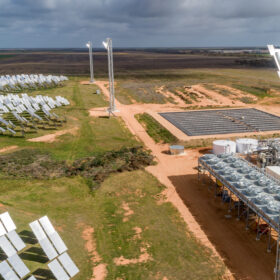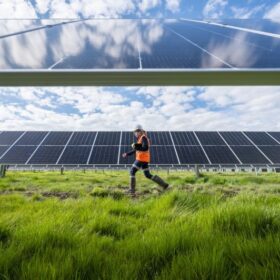The claims were included in VEPC’s submission to the recent public consultation regarding the VNI West project – a major new transmission development that will provide a significant interconnection between the Victorian and NSW transmission grids.
VNI West will also open up new areas in Victoria for sustainable renewable energy generation development.
AEMO’s Executive General Manager System Design, Merryn York said AEMO had received more than 500 submissions in relation to the VNI West consultation report, demonstrating significant interest in the alternate options for the project, including where it links to the Western Renewables Link transmission project.
She said the authors of VEPC’s submission had engaged with AEMO on a number of occasions during the public consultation period and had the opportunity to ask questions and receive responses to their enquiries from subject experts at AEMO, Transgrid, EY and Houston Kemp.
A response to the VEPC submission will be published along with responses to all the written submissions to the consultation report following the publication of the final regulatory report for the project in May.
VEPC’s submission makes a series of claims related to the broader electricity system that are contrary to both government policy and numerous independent economic analyses of the energy transition.
Recent publications from Net Zero Australia, the Clean Energy Investor Group, the International Energy Agency and The Economist, which chose transmission as the global cover story for its recent edition, do not support the broad theses in VEPC’s submission.
Victoria needs to develop capacity in both Gippsland and north-west Victoria
The VEPC submission claims that proposed or possible renewable energy generation developments in the Gippsland region could be transported using existing transmission lines, offsetting the need for the VNI West line.
Ms York described VEPC’s claim as at odds with the views and analyses of transmission businesses and generators, who participated in the public consultation process to develop the ISP as well as AEMO’s independent, expert analysis.
“Detailed engineering and economic analysis in our ISP demonstrate Victoria will need to harness both existing transmission between the Latrobe Valley and Melbourne and build new transmission infrastructure to connect renewable generation from the west and northwest regions of Victoria with demand in towns and cities across the state,” she said.
“This is not an either-or situation – robust expert modelling detailed in multiple iterations of the ISP demonstrates that new transmission infrastructure is needed in both the east and the west of Victoria to ensure secure electricity supply to meet growing demand from Victorian consumers.
VNI West and WRL unlock new capacity and provide diversity of generation
“VNI West provides vital insurance against weather patterns in Victoria and an economy that is increasingly reliant on energy from variable, renewable generation.
“It’s crucial back-up for those still days in the Bass Strait when Gippsland’s wind turbines are idle, providing access to the sunshine in the northwest to power homes and workplaces throughout Victoria.
“And on days when it is sunny and windy across the state, VNI West will export excess electricity from Victoria to Snowy 2.0, where it will be used to pump water up the hill. Then on cloudy and still days when renewable output is low, that water can be released and electricity brought back into Victoria using the same transmission lines.”
VNI West and WRL will not double the transmission charges paid by consumers
Ms York also refuted VEPC’s claims that the VNI West and WRL projects would double or even triple the transmission cost component in Victorian electricity bills.
“We estimate an increase in the order of 25% for consumers in the Victorian transmission cost component as a result of the VNI West and WRL projects, however this will be more than offset by lower wholesale costs from utilising a portfolio of renewable generation sources,” she said.
AEMO described comments in VEPC’s submission on the potential for increased acts of sabotage as reckless, saying Victoria was already home to more than 6,000 kilometres of existing transmission line.
“There are transmission lines that deliver electricity to customers throughout Australia, so suggesting additional lines would increase risks is not supported by any evidence,” she said.
Comments in VEPC’s submission on fire risk were misguided. Transmission of this scale does not represent a significant risk in terms of starting fires.
Energy Safe Victoria recently published a guide to bushfire management and community safety around transmission lines, addressing a range of key issues including how companies that own and maintain transmission lines work with fire authorities to ensure that aerial firefighting is possible in the vicinity of transmission lines.
AEMO chief executive Daniel Westerman said the urgent need for new transmission to bridge the gap left by the rapid exit of coal-fired generation was not unique to Australia.
“Governments and system planners worldwide are wrestling with the urgent need to build new transmission to guarantee the safe, secure and reliable supply of basic services to towns and cities,” Mr Westerman said.
“The rigour and public consultation process we undertake to develop the ISP has earned AEMO widespread recognition and is fundamental to ensuring robust, evidence-based decision making to maintain downward pressure on electricity prices.
“AEMO is proud to be Australia’s independent, not-for profit, system operator and system planner. Our staff are recognised globally as experts in their field, and act solely in the best long-term interests of Australian energy consumers.”
The VNI West Project Assessment Conclusions report will be published here in May along with the submissions and responses to submissions for the consultation report, which concluded on Wednesday 5 April, 2023.






By submitting this form you agree to pv magazine using your data for the purposes of publishing your comment.
Your personal data will only be disclosed or otherwise transmitted to third parties for the purposes of spam filtering or if this is necessary for technical maintenance of the website. Any other transfer to third parties will not take place unless this is justified on the basis of applicable data protection regulations or if pv magazine is legally obliged to do so.
You may revoke this consent at any time with effect for the future, in which case your personal data will be deleted immediately. Otherwise, your data will be deleted if pv magazine has processed your request or the purpose of data storage is fulfilled.
Further information on data privacy can be found in our Data Protection Policy.